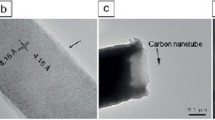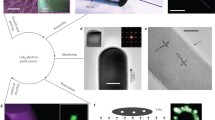Abstract
Electric field-induced point electron source is highly demanded for microscopy, spectroscopy, lithography, X-ray tubes, microwave devices, and data displays. However, the instability in emission current and requirement of ultrahigh vacuum have often limited its extensive applications. Herewith we report a single-crystalline HfC nanowire with oxycarbide emission surface for stable electron emission at 50 nA with fluctuations less than 1% in a vacuum of 4 × 10−7 Pa. The emitter has a low work function of 2.5 eV measured by the field emission Fowler-Nordheim curve and it is in good agreement with density functional theory (DFT) calculations. The energy spread is in a range of 0.21–0.26 eV with a corresponding reduced brightness 1.95 × 1011−3.81 × 1011 A·m−2·sr−1·V−1. The HfC nanowire with oxycarbide emission surface is a qualified candidate for the next-generation electron source with high brightness, large current, and low energy spread.

Similar content being viewed by others
References
Crewe, A. V.; Eggenberger, D. N.; Wall, J.; Welter, L. M., Electron gun using a field emission source. Rev. Sci. Instrum., 1968, 39, 576–583.
de Heer, W. A.; Châtelain, A.; Ugarte, D., A carbon nanotube field-emission electron source. Science, 1995, 270, 1179–1180.
Houdellier, F.; de Knoop, L.; Gatel, C.; Masseboeuf, A.; Mamishin, S.; Taniguchi, Y.; Delmas, M.; Monthioux, M.; Hÿtch, M. J.; Snoeck, E., Development of TEM and SEM high brightness electron guns using cold-field emission from a carbon nanotip. Ultramicroscopy, 2015, 151, 107–115.
Guo, G. X.; Tokunaga, K.; Yin, E.; Tsai, F. C.; Brodie, A. D.; Parker, N. W., Use of microfabricated cold field emitters in sub-100 nm maskless lithography. J. Vac. Sci. Technol. B, 2001, 19, 862–865.
Zhang, J.; Yang, G.; Cheng, Y.; Gao, B.; Qiu, Q.; Lee, Y. Z.; Lu, J. P.; Zhou, O., Stationary scanning X-ray source based on carbon nanotube field emitters. Appl. Phys. Lett., 2005, 86, 184104.
Teo, K. B. K.; Minoux, E.; Hudanski, L.; Peauger, F.; Schnell, J. P.; Gangloff, L.; Legagneux, P.; Dieumegard, D.; Amaratunga, G. A. J.; Milne, W. I., Microwave devices: Carbon nanotubes as cold cathodes. Nature, 2005, 437, 968.
Chen, J.; Dai, Y. Y.; Luo, J.; Li, Z. L.; Deng, S. Z.; She, J. C.; Xu, N. S., Field emission display device structure based on double-gate driving principle for achieving high brightness using a variety of field emission nanoemitters. Appl. Phys. Lett., 2007, 90, 253105.
Xu, N. S.; Huq, S. E., Novel cold cathode materials and applications. Mat. Sci. Eng. R, 2005, 48, 47–189.
Schwind, G. A.; Magera, G.; Swanson, L. W., Comparison of parameters for Schottky and cold field emission sources. J. Vac. Sci. Technol. B, 2006, 24, 2897–2901.
Swanson, L. W.; Schwind, G. A., A review of the cold-field electron cathode. Adv. Imag. Elec. Phys., 2009, 159, 63–100.
Kasuya, K.; Katagiri, S.; Ohshima, T.; Kokubo, S., Stabilization of a tungsten <310> cold field emitter. J. Vac. Sci. Technol. B, 2010, 28, L55–L60.
Andrievskii, R. A.; Strel’nikova, N. S.; Poltoratskii, N. I.; Kharkhardin, E. D.; Smirnov, V. S., Melting point in systems ZrC-HfC, TaC-ZrC, TaC-HfC. Powder Metall. Met. Ceram, 1967, 6, 65–67.
Williams, W. S., Electrical properties of hard materials. Int. J. Refract. Met. Hard Mat., 1999, 17, 21–26.
Opeka, M. M.; Talmy, I. G.; Wuchina, E. J.; Zaykoski, J. A.; Causey, S. J., Mechanical, thermal, and oxidation properties of refractory hafnium and zirconium compounds. J. Eur. Ceram. Soc., 1999, 19, 2405–2414.
Yu, M. L.; Hussey, B. W.; Kratschmer, E.; Chang, T. H. P., Improved emission stability of carburized HfC< 100> and ultrasharp tungsten field emitters. J. Vac. Sci. Technol. B, 1995, 13, 2436–2440.
Kagarice, K. J.; Magera, G. G.; Pollard, S. D.; Mackie, W. A., Cold field emission from HfC (310). J. Vac. Sci. Technol. B, 2008, 26, 868–871.
Liu, W.; Zheng, W. T.; Jiang, Q., First-principles study of the surface energy and work function of III-V semiconductor compounds. Phys. Rev. B, 2007, 75, 235322.
Mackie, W. A.; Morrissey, J. L.; Hinrichs, C. H.; Davis, P. R., Field emission from hafnium carbide. J. Vac. Sci. Technol. A, 1992, 10, 2852–2856.
Otani, S.; Tanaka, T., Preparation of HfC single crystals by a floating zone technique. J. Cryst. Growth, 1981, 51, 381–386.
Rogl, P.; Naik, S. K.; Rudy, E., A constitutional diagram of the system TiC-HfC-WC. Monatsh. Chem., 1977, 108, 1189–1211.
Yuan, J. S.; Zhang, H.; Tang, J.; Shinya, N.; Nakajima, K.; Qin, L-C., Synthesis and characterization of single crystalline hafnium carbide nanowires. J. Am. Ceram. Soc., 2012, 95, 2352–2356.
Fowler, R. H.; Nordheim, L., Electron emission in intense electric fields. Proc. R. Soc. Lond. A, 1928, 119, 173–181.
Zhang, H.; Tang, J.; Zhang, Q.; Zhao, G.; Yang, G.; Zhang, J.; Zhou, O.; Qin, L-C., Field emission of electrons from single LaB6 nanowires. Adv. Mater., 2006, 18, 87–91.
Swanson, L. W.; Martin, N. A., Field electron cathode stability studies: Zirconium/tungsten thermal-field cathode. J. Appl. Phys., 1975, 46, 2029–2050.
Bronsgeest, M. S.; Barth, J. E.; Swanson, L. W.; Kruit, P., Probe current, probe size, and the practical brightness for probe forming systems. J. Vac. Sci. Technol. B, 2008, 26, 949–955.
Young, R. D., Theoretical total-energy distribution of field-emitted electrons. Phys. Rev., 1959, 113, 110–114.
Gambardella, P.; Šljivančanin, Ž.; Hammer, B.; Blanc, M.; Kuhnke, K.; Kern, K., Oxygen dissociation at Pt steps. Phys. Rev. Lett., 2001, 87, 056103.
Dahl, S.; Logadottir, A.; Egeberg, R. C.; Larsen, J. H.; Chorkendorff, I.; Törnqvist, E.; Nerskov, J. K., Role of steps in N2 activation on Ru(0001). Phys. Rev. Lett., 1999, 83, 1814–1817.
Snijders, P. C.; Rogge, S.; González, C.; Pérez, R.; Ortega, J.; Flores, F.; Weitering, H. H., Ga-induced atom wire formation and passivation of stepped Si (112). Phys. Rev. B, 2005, 72, 125343.
Shimada, S.; Inagaki, M.; Matsui, K., Oxidation kinetics of hafnium carbide in the temperature range of 480° to 600° C. J. Am. Ceram. Soc., 1992, 75, 2671–2678.
Giannozzi, P.; Baroni, S.; Bonini, N.; Calandra, M.; Car, R.; Cavazzoni, C.; Ceresoli, D.; Chiarotti, G. L.; Cococcioni, M.; Dabo, I., QUANTUM ESPRESSO: A modular and open-source software project for quantum simulations of materials. J. Phys.: Condens. Matter, 2009, 27, 395502.
Vanderbilt, D., Soft self-consistent pseudopotentials in a generalized eigenvalue formalism. Phys. Rev. B, 1990, 41, 7892–7895.
Perdew, J. P.; Burke, K.; Ernzerhof, M., Generalized gradient approximation made simple. Phys. Rev. Lett., 1996, 77, 3865–3868.
Monkhorst, H. J.; Pack, J. D., Special points for Brillouin-zone integrations. Phys. Rev. B, 1976, 13, 5188–5192.
Acknowledgements
We thank Prof. K. Hono for helpful discussions on the FIM and atom probe results. This work was supported partially by the NIMS-DENKA Centre of Excellence for Next Generation Materials. A part of this work was also supported by NIMS Microstructural Characterization Platform as a program of “Nanotechnology Platform” of the Ministry of Education, Culture, Sports, Science and Technology (MEXT), Japan.
Author information
Authors and Affiliations
Corresponding authors
Rights and permissions
About this article
Cite this article
Tang, S., Tang, J., Chiu, Tw. et al. A HfC nanowire point electron source with oxycarbide surface of lower work function for high-brightness and stable field-emission. Nano Res. 13, 1620–1626 (2020). https://doi.org/10.1007/s12274-020-2782-0
Received:
Revised:
Accepted:
Published:
Issue Date:
DOI: https://doi.org/10.1007/s12274-020-2782-0




